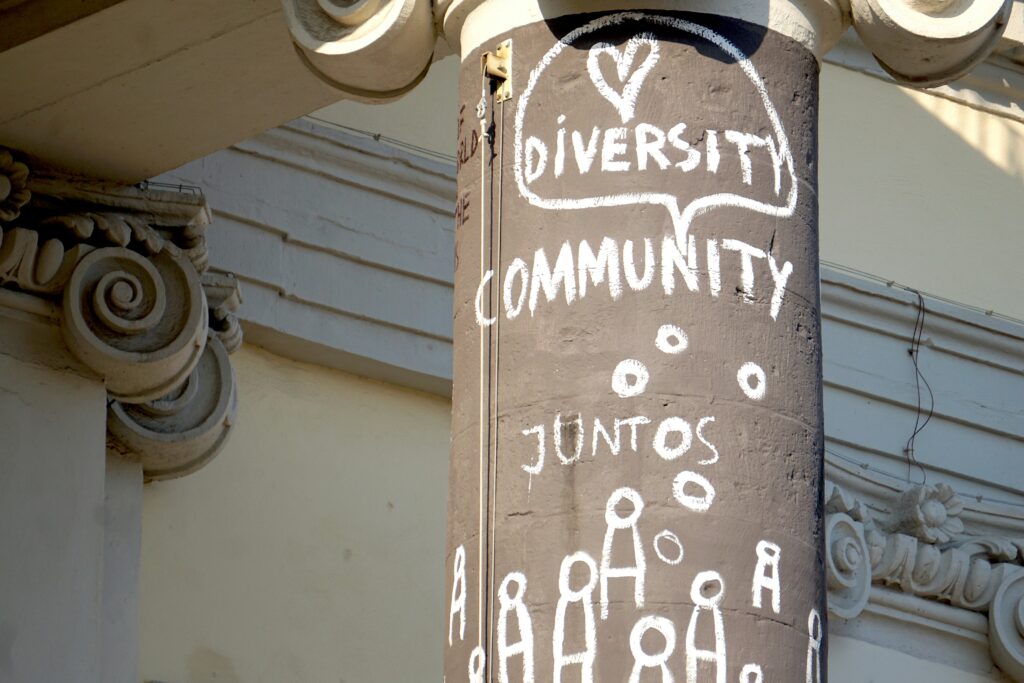Choose a Theme with Meaning
A mural isn’t just paint on a wall—it’s a message. Before you dive into sketches or color palettes, it’s crucial to decide what your mural should ultimately say or represent.
Define Your Message
Ask yourself: What’s the story or idea behind the mural? This helps guide all future decisions, from the imagery and color scheme to the layout.
- Is the mural meant to inspire, commemorate, or provoke thought?
- Will it highlight a local issue, historical event, or a shared community value?
Being intentional will ensure the mural resonates with viewers long after it’s painted.
Consider Cultural and Social Relevance
The strongest murals speak to the people who walk past them every day. Take the time to reflect on what matters to the surrounding community:
- Cultural traditions or symbols that should be honored
- Local history that deserves visibility
- Social messages or movements worth amplifying
A relevant mural connects emotionally and can even become a landmark.
Engage the Community Early
Art in public spaces should reflect the people who live there. Don’t wait until you’re nearly finished to loop in the community.
- Host listening sessions or informal surveys to collect input
- Collaborate with local schools, organizations, or elders
- Use feedback to refine your vision and build trust
Involving others not only brings fresh ideas—it ensures the project is rooted in shared values.
Introduction
Vlogging hasn’t just survived the digital shifts of the last few years—it’s adapted, morphed, and come out sharper. As short-form noise floods the internet and attention spans remain short, vloggers who stay grounded in authentic storytelling and audience connection have found ways to cut through. The core strength of vlogging—unfiltered, personality-driven content—has proven surprisingly durable, even as platforms and preferences change fast.
Now 2024 introduces a fresh set of terms. Platforms are tweaking algorithms, AI tools are becoming part of everyday workflows, and audiences are zeroing in on content that feels both real and specific. It’s no longer about being everywhere—it’s about being intentional, consistent, and connected to a clear message or niche. For creators, this isn’t a time to coast. It’s a moment to retool, refocus, and lean into what actually builds trust and community.
Choosing the Right Location for Your Shoot
Before you hit record, get your location squared away. First step: permission. Whether it’s a private driveway, alley wall, or public plaza, always reach out to the property owner or local authorities. Skipping this can land you in legal trouble or get your video pulled.
Next, think visibility. Can people see you clearly on camera? Is the backdrop accessible without a 20-minute hike? And don’t forget safety—trip hazards, sketchy wiring, or crumbling steps aren’t worth the risk just for a unique shot.
Lastly, look at what you’re filming against. Surface type matters. Brick can add texture but might shadow weird under sunlight. Wood can look warm but warps in humid weather. Smooth concrete is reliable but sometimes too plain. Choose something that matches your vibe and won’t ruin your look mid-shoot.
Recruit the Right Team to Build Momentum
Getting the right people on board early changes everything. Start local—reach out to community artists, students hungry for experience, or volunteers who care about the project’s message. Don’t wait for perfect resumes; look for energy, creativity, and follow-through.
Then define roles clearly. You’ll need a lead artist to drive the visual identity, a logistics support person to wrangle permits and materials, someone to manage schedules and timelines (project manager), and a media coordinator to capture content and push it out. These roles don’t need to be siloed, but they do need to be understood.
Next, host a short, focused kickoff meeting. Set expectations. Share the goals. Walk through the timeline. Leave space for questions, but keep it tight. People step up when they know what’s coming and why it matters. That alignment upfront saves chaos later.
Budgeting Smart for Vlog-Ready Visual Setups
If you’re planning to build out a vlogging backdrop or shoot on location, costs stack up quickly. You’ll need to budget for essentials like paint, brushes, scaffolding (if you’re filming large murals or exterior pieces), and never forget permits—especially if you’re shooting in public or modifying property. Underestimating these basics can kill momentum fast.
Good news: money doesn’t have to be a blocker. Local arts grants, small business sponsorships, and crowdfunding platforms like Kickstarter or GoFundMe still work—especially if you have a niche audience. Pitch your project as a community creation or creative collaboration, and people are more willing to chip in than you’d think.
When buying materials, go for quality. Weather-resistant paint, UV-proof sealants, and durable construction gear can double the lifespan of whatever you’re building or filming against. It’s tempting to go cheap, but trust: replacing worn-out backdrops or peeling paint halfway through your content schedule isn’t just annoying—it’s expensive.
Collaboration is no longer a nice-to-have in vlogging—it’s a strategy. In 2024, smart creators are pulling their communities into the content process from day one. Start by hosting brainstorming sessions where your audience can toss in raw ideas. You’ll get a better read on what they actually care about and avoid guessing blindly.
Don’t just target superfans or one demographic. Let different age groups chime in. Their perspectives can shape segments, suggest themes, or even co-create intros and questions that resonate wider.
To keep things simple and scalable, build basic content templates. These might be story frameworks, question prompts, or visual formats your audience can plug into—even if they’ve never touched editing software. You’re not outsourcing creativity; you’re widening the lens. Everyone gets a seat at the table.
If you’re looking for inspiration, check out this piece: Weekend Project – Creating Abstract Art with Everyday Items. It’s a perfect example of how low-barrier participation opens the floodgates for creativity.
Plan the Paint Day Like a Pro
First, don’t just wing it—set a clear timeline. Whether you’re working with five people or fifty, everyone needs to know when things start, what’s expected hour by hour, and what milestones need to be hit. This isn’t about being rigid. It’s about giving your team—especially volunteers—direction so momentum builds instead of stalling out halfway through.
Next, break the mural into zones or stages. Assigning specific sections, themes, or tasks helps avoid crowding and confusion. It also makes it easier to track progress. One corner could be sketching, another could be painting backgrounds, and elsewhere you layer in details. Think of it as creative traffic flow.
Lastly, never underestimate the power of creature comforts. You’re not just managing a project—you’re building a vibe. Keep water stocked, have snacks that don’t melt too fast, and throw up some shade if the sun’s out. Good music helps too. When people feel looked after, the energy stays strong and the paint keeps flowing.
If you’re launching a new vlog project or building momentum around an initiative, don’t just talk to your camera—talk to your audience where they already are. Use social platforms like Instagram, YouTube Community, and Reddit boards to shout out what you’re working on and invite people in. Short, clear calls to action do best: tell them what it is, how they can join, and why it matters.
As things unfold, document the journey. Snap behind-the-scenes photos. Record candid micro-interviews. The vibe should be raw but intentional—content that feels personal, not staged. This isn’t about polish; it’s about presence.
Once people start showing up or contributing, make space for them. Encourage viewers to tag themselves in your vlog, drop their thoughts in the comments, or share clips of their involvement. When followers see their voices reflected back, they stick around—and invite others too.
Hosting a small unveiling or celebration isn’t just symbolic—it marks the shift from project mode to community presence. Keep it simple: a live stream, a local gathering, or even a casual behind-the-scenes vlog can do the job. The key is making it accessible and authentic.
Publicly shout out everyone who made it happen. The editors, the camera crew, the on-screen talent—even the folks who handled logistics. Recognition builds trust and morale, and audiences respect creators who credit their teams.
Then there’s upkeep. Decide early who’s in charge of touch-ups: visual branding, content structure, upload schedules, or tech refinements. Is it a monthly audit by your editor? A seasonal rebrand check-in? Nail it down. Sustainable vlogging isn’t about endless hustle—it’s about systems that keep the engine running without burning it out.
A mural isn’t just paint on brick—it’s a voice in color, a local story told loud. The best ones aren’t dropped in from above. They come from the block, shaped by the people who walk past them every day. That’s the power of public art: it turns blank spaces into belonging spots.
Getting started doesn’t require a fine arts degree or city funding, but it does take planning. Talk to building owners, team up with local artists, get the neighborhood involved early. When people feel like they’re part of the process, they’re more likely to protect and celebrate the result. Leave room for ideas to shift—sometimes the wall tells you what it wants.
The best murals are flexible, inclusive, grounded in place. If it looks like it could only exist right there, then it’s doing its job. Let the colors carry a message, but let the community fill in the meaning.

 Johner Hazardics brought essential structural and technical support to FLP Emblemable, assisting in the development of its layout, functionality, and user-focused features. His dedication to smooth performance and intuitive design helped the platform grow into a reliable and engaging space for artists and enthusiasts alike.
Johner Hazardics brought essential structural and technical support to FLP Emblemable, assisting in the development of its layout, functionality, and user-focused features. His dedication to smooth performance and intuitive design helped the platform grow into a reliable and engaging space for artists and enthusiasts alike.